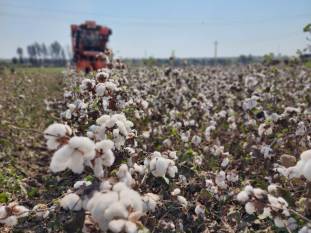NAGPUR, 7 November 2024: Cotton farmers in Maharashtra are transforming their cultivation practices by adopting the High-Density Planting System (HDPS), a method set to significantly enhance productivity while addressing challenges of low yields and labour shortages.
This innovative approach has shown promising results, with reports indicating a potential increase of 30-40% in cotton productivity per acre. The shift is expected to stabilise the domestic textile industry, which has faced supply constraints since the pandemic.
India, despite being the largest global cotton producer, ranks 44th in terms of productivity. Maharashtra, one of the key cotton-growing states, has faced similar challenges. While the state accounts for a significant portion of India's cotton-producing area, it has historically struggled with productivity. The introduction of HDPS aims to reverse this trend by increasing plant population per acre and encouraging mechanisation.
Rasi Seeds has played a vital role in this transformation through its 'Rasi Max Project'. In collaboration with ICAR-CICR & Krishi Vigyan Kendra (KVK) scientists and local farmers, the initiative has introduced hybrid seeds specifically amicable for HDPS. This method allows farmers to increase plant population by up to four times, with approximately 26,000 plants per acre compared to traditional methods.
Sathyanarayana Rao H G, Head of Marketing for Cotton at Rasi Seeds, highlighted the broader impact of the Rasi Max Project: "Through the HDPS Project, farmers receive specialized training on customized agronomy and advanced pest and nutrient management practices. The success we've seen in Maharashtra serves as a model for other cotton-growing regions. In this HDPS project, we have collaborated with key external stakeholders to build a supportive ecosystem. We’re working with machinery firms for pneumatic planters & Cotton Pickers, crop protection companies for defoliation and plant growth regulators (PGRs), Central institutions for tailored agronomic solutions, and textile companies for post-harvest machinery. This program not only boosts productivity for individual farmers but also strengthens the agricultural community by driving an overall increase in cotton productivity.
Dilip Thakare, a farmer from Malwada village in Akola district, shared his experience: “With HDPS and the Rasi Swift and RCH 929 hybrids, I’ve seen a significant improvement in my yields. The method has allowed me to plant more effectively while reducing my reliance on manual labour during harvest season.”
Another farmer, Anil Tekade from Morgaon Sadijan in Akola district, expressed his satisfaction with the project: “The Rasi Max Project has changed the way we approach cotton farming. With HDPS and Rasi Swift Hybrid, I can now cultivate more plants in the same area, making the process more efficient.”
Kishor Kukade from Agar village in Akola district added, “The improvements I’ve noticed since adopting HDPS are remarkable. I no longer worry about the labour costs during harvesting, thanks to mechanisation. This method is definitely the way forward for cotton farming.”
As part of a nationwide initiative to enhance cotton productivity, the success of the High-Density Planting System (HDPS) in Maharashtra is paving the way for sustainable agricultural growth. Currently, HDPS covers over 22,000 acres, with 1,962 farmers actively participating. Critical innovations—such as pneumatic planters for precise sowing, boom sprayers for efficient chemical application, fertilizer spreaders, intercultural tools, and mechanical cotton pickers—are boosting productivity, securing fiber supply, and reinforcing India’s position in the global textile market.
With millions of farmers and workers reliant on this industry, the adoption of HDPS and similar advancements is not just crucial but transformative. Together, these efforts herald a new era of resilience and profitability, ensuring India’s cotton sector remains robust and future-ready.























